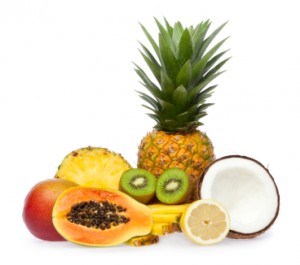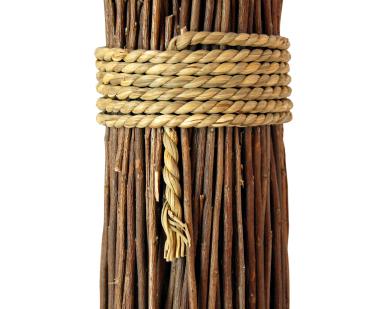 Exotic tropical plants can be grown for more than just their lush beauty. Some of these plants are edible as well, and even in the middle of winter they can reward a patient gardener with unique spices or sweet fruits for the family to enjoy. There is something very satisfying in peeling a tangerine from your own personal tree or being greeted with the aroma of passionflower blooms during the cold months. The best part is that these tasty tropical fruits are often surprisingly easy to grow indoors.
Exotic tropical plants can be grown for more than just their lush beauty. Some of these plants are edible as well, and even in the middle of winter they can reward a patient gardener with unique spices or sweet fruits for the family to enjoy. There is something very satisfying in peeling a tangerine from your own personal tree or being greeted with the aroma of passionflower blooms during the cold months. The best part is that these tasty tropical fruits are often surprisingly easy to grow indoors.
Benefits
Exotic crops bring several benefits to the family. Many of them are packed with nutrients like vitamin C, while others promote better overall health with antioxidant properties. Growing these tropical fruits and spices also introduces more variety to your family’s diet and gives you to opportunity to grow unique and hard-to-find foods. In addition, growing your own tropical container garden allows you to enjoy foods like fresh coffee, bananas, and citrus without depending on grocery stores that may import fruit from thousands of miles away.
Popular Exotic Container Plants
Growing tropical fruits and spices is surprisingly easy, especially with select varieties that were cultivated for thriving in containers. For a fun garden project during the long winter months this year, try to grow one or more of the following exotic plants in a container indoors. All of these make attractive houseplants when not fruiting or in bloom, and many have the added bonus of fragrant, attractive flowers in addition to the nutritious food they provide.
Citrus
Citrus trees in general are not heavy-yielding when grown indoors at first, but their delightfully fragrant flowers and tart fruits are well worth the wait. The only caveat with citrus is that they tend to be a magnet for bugs. Check your citrus tree for pests on a regular basis, and wash the leaves at the first sign of them to keep your plants bug-free and happy.
There are many varieties of citrus to choose from, including some that are specially cultivated to growing and fruiting indoors. The Meyer Improved Lemon is a popular choice and ideal for beginners. It grows well in containers and reliably produces sweet juicy lemons and fragrant blooms for years. Tangerines are another popular citrus for indoor growing. They are hardy and attractive plants that are known to fruit heavily. Other great citrus varieties for growing indoors include the Kaffir Lime, Calamondin Orange, and Variegated Pink Lemon.
Passion Fruit
Passion fruit is a vigorous vine that produces stunning exotic flowers and sweet aromatic fruit. There are more than 400 species of Passiflora, but the ones that are best for harvesting fruits are the tasty tropical varieties. Growing a fruiting passion vine is a rewarding experience. The lush, evergreen leaves and stunning flowers alone make this vine an excellent addition to the home. The sweet, purple-fruited tropical passion fruit varieties perform especially well indoors and only need regular pruning to keep looking their best. Passion fruit is delicious eaten raw or made into jam or juice.
Pineapple
Pineapples are easily one of the best tropical fruits for growing indoors. Their small stature doesn’t take up as much space as the larger trees, and they are ridiculously easy to grow from the spiky tops of the pineapple fruit. These plants are actually a type of bromeliad, and this becomes obvious when you see them bloom. Like all bromeliads, pineapples enjoy bright, indirect light and don’t require rich heavy soil to thrive. A young pineapple plant will produce one fruit after eighteen to twenty-four months, which seems like a long time, but these plants will produce yearly after that. In addition, pineapples reproduce easily. The tops of their fruits can be planted to grow into another pineapple plant, and one to three young pineapple starts (often called “pups”) appear on a mature plant once it finishes fruiting.
Banana
Bananas are the quintessential tropical plant. They have large, lush leaves and produce racks of fresh, nutritious fruit. Thanks to cultivation efforts, bananas can now be grown, quite easily, in containers. One huge advantage to growing your own bananas is the access to unique varieties that are so much more interesting and flavorful than the starchy bananas found at the store. There are several dwarf and super-dwarf varieties of bananas to choose from that are sure to thrive and fruit in a pot, and many of them start flowering at only three feet tall! Bananas prefer bright, filtered light and plenty of water. They also require a bit more humidity than is found in most households. A simple mister or even trays of water should be enough to keep your banana plant healthy.
Black Pepper
The spicy taste and aroma of black pepper is a favorite throughout the world. Rather than making trips to the local grocery store for imported black pepper, why not grow and grind your own? The small little peppercorns actually come from a tropical vine of South Asia, and when given enough light and warmth, can yield heavily indoors as well.
Vanilla
One of the most popular – and most expensive – spices is vanilla. This flavorful bean, coveted by so many, is actually a type of orchid. It has a delicate vine-like habit with soft golden-yellow flowers that resemble dendrobium orchid blooms. Vanilla is a slow-growing plant that needs plenty of bright sunlight and humidity to thrive. When properly cared for, however, it will reward the gardener with delightful vanilla pods, perfect to use for cooking.
Guava
Guavas are tough little trees that perform well in containers, and their fruits are a true taste of the tropics. The sweet-tart fruits are great eaten raw off the tree or can be made into juices and jams. When not fruiting, guavas make attractive houseplants with peeling bark and small, glossy leaves that have a light, pleasant scent. Guava has similar light and water requirements to citrus – they appreciate plenty of bright sunshine. Outdoor varieties of guava can get over fifteen feet tall, so make sure to find a dwarf variety to grow indoors.
Coffee
With its famous red berries that can be roasted and made into a rich brew, coffee is a surprisingly attractive tree. The bright red berries contrast with the dark green foliage, and the soft white flowers are delightfully fragrant. The coffee tree needs plenty of bright light and moist soil to thrive indoors and must be kept away from cold drafts. It takes two to three years for a young tree to start producing, and the light and water conditions must be perfect, but it is possible to grow and roast your own quality coffee beans indoors. With a little TLC and some patience, the results will be well worth it.
Growing Exotic Crops
All tropical plants, whether fruiting or not, come with unique challenges as well as rewards. Following are some common problems that gardeners may face when growing these exotics indoors:
- Fruiting/Flowering Problems: Vibrant and healthy tropical plants are known to go years without so much as a flower bud, and tropical trees in particular can take a few years before they’re mature enough to start blooming. To help increase your chances of a productive exotic tree or vine, be sure to plant a quality variety that is known to produce indoors, and carefully follow the flowering requirements.
- Keeping Warm: While many of the listed plants can tolerate a light frost, others (such as coffee and passion fruit) need to be protected from temperatures below 50°F, with ideal temperatures in the 65 to 80°F range.
- Light: A big detriment to growing indoors is the lack of bright, unfiltered sunlight. Some gardeners like to supplement with a full-spectrum light, and most tropical plants appreciate being brought outside in the sun during summer months.
- Humidity: Many tropical plants can survive just fine with the humidity levels found in most households, but some are more sensitive and could use a humidity boost, especially during the drier winter months. Coffee, banana, and vanilla plants are especially picky and need to be misted or kept near a humidifier in order to remain healthy.
Finding Container Tropical Fruits
Because there are relatively few cultivars of tropical fruits and spices that thrive and fruit in containers, the options for finding them can be somewhat limited. Many nurseries will special-order for interested customers, and online retailers, such as Logee’s Greenhouses based out of Connecticut, can be a good option. Often, these greenhouses create their own hybrids or travel in search of new dwarf varieties.
The exotic fruits and flowers of tropical plants may take some effort to achieve indoors, but thanks to years of selective breeding, are no longer impossible for gardeners to enjoy. By providing adequate light, water, warmth and humidity, households across the country can savor a taste of the tropics indoors.
References:
https://www.logees.com/Tropical-Fruits/products/461/0/3
https://www.weekendgardener.net/fruit/grow-bananas-indoors-011001.htm
https://www.extension.umn.edu/yardandgarden/ygbriefs/h106citrus.html
https://www.coffeeresearch.org/agriculture/homegrowing.htm
https://www.crfg.org/pubs/ff/passionfruit.html
©2012 Off the Grid News










